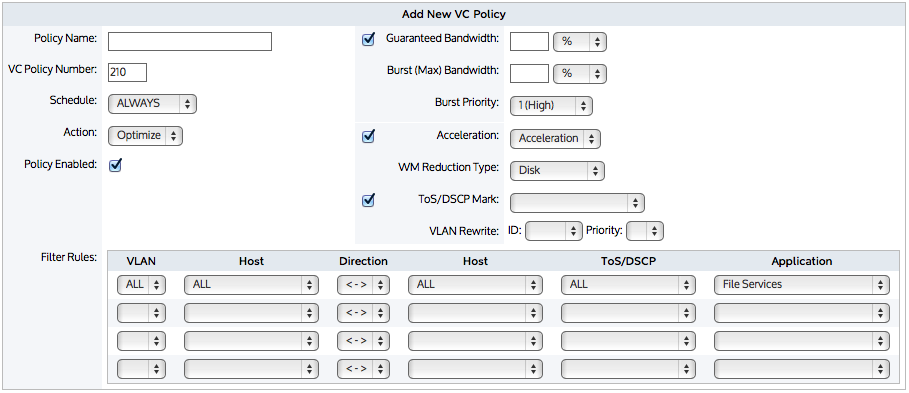Version Info:
HTTP Redirect is available in 7.0.1 and above in the 7.0 firmware product line and in 6.4.5 and above in the 6.4 firmware product line.
Policies define what actions to perform on specific targeted traffic. The policies can specify whether to optimize the traffic (by bandwidth shaping, accelerating, or marking the packets), block the traffic (by discarding the packets), monitor the traffic (by ignoring the packets), or redirect the traffic to a specific URL.The traffic that the policy acts upon can be filtered by application or application group, by hosts or subnets, by hosts or subnets that are communicating with other specific hosts or subnets, by VLAN, by ToS/DSCP markings, and by time of day. Any combination of these filters can be applied. That is, the policy could be targeted to SAP traffic between a particular branch and headquarters, which have particular ToS markings on a particular VLAN during work hours. Furthermore, you can add more than one filter. That is, the policy could target a particular branch site for Netflix and the same branch site for Silverlight.
|
|
Version Info: HTTP Redirect is available in 7.0.1 and above in the 7.0 firmware product line and in 6.4.5 and above in the 6.4 firmware product line. |
|---|
When policies are created they are added to the policy library. Therefore, any changes made to a policy definition will affect all other virtual circuits that use that policy.

Policies are part of the policy tree. To learn how circuits, virtual circuits, and policies work together, see Policy Tree.
Go to Configuration > Traffic Policies > Optimizer > Optimizer, then click the Create Policy ... link at the bottom of each virtual circuit or edit an existing policy.
Or go to Configuration > Traffic Policies > Optimizer > Policies and create or edit a policy in the policy library.
The default is ALWAYS. Schedules that have been defined will appear in the drop-down list. Schedules can be created via Configuration > Objects > Schedules.
Version Info: HTTP Redirect is available in 7.0.1 and above in the 7.0 firmware product line and in 6.4.5 and above in the 6.4 firmware product line. |

Note
|
Click Add New Policy to add this policy to the policy tree.
The policy will also be added to the policy library.

This is the amount of bandwidth that the policy will have available if needed. This is not reserved bandwidth. If the policy does not use the entire guaranteed bandwidth, the excess bandwidth will be made available for use by other policies in the virtual circuit.
The guaranteed bandwidth of a single policy must not exceed the parent virtual circuit bandwidth.
The sum of all guaranteed bandwidths for each policy within a virtual circuit must not exceed the virtual circuit bandwidth.
This is the maximum amount of bandwidth that the policy can have access to if there is excess bandwidth available.
The burst bandwidth must be greater than the guaranteed bandwidth, and less than or equal to the parent virtual circuit bandwidth.
If excess bandwidth is available, the burst priority is used to decide how excess bandwidth is distributed. Policies with a higher burst priority will be preferred when allocating excess bandwidth.

Compression - Compress the traffic using a network optimized LZ compression algorithm. The traffic will also be TCP-accelerated.
Note If the compressed output is larger than the original, the appliance will send the original. |

For more information, refer to the DSCP/ToS How to Guide.
|
|
Note If you select the Optimize Action and then select the Packet Marking checkbox, the interface provides an opportunity to use a VLAN Rewrite feature by selecting an ID and a Priority from drop down lists. While the option is there, the feature has been disabled and will be removed in a future version of the software. |
|---|

This option can be used in conjunction with a uni-directional virtual circuit to discard connections originating from a specific side (WAN or LAN) of the appliance. For example, when used with an inbound Virtual Circuit, the first (SYN) packet will be discarded - effectively blocking connection establishment from the WAN but allowing traffic from established connections.
The HTML Response object allows you to "host" a webpage on the Exinda appliance. You create the HTML Response webpage on Configuration > Objects > HTML Response. See Configure HTML Response Object.
Traffic matching this policy will be returns the HTTP webpage, which will cause the webpage to be presented to the client browser. This option is useful to notify users when they are no longer allowed to use the network for HTTP, HTTP-ALT, or HTTPS traffic.
Similar to other policy configurations, you can specify VLAN, Host/Direction/Host, ToS/DSCP, or Application. However, the only allowable applications are HTTP, HTTP-ALT, and HTTPS.
Traffic matching this policy will be forwarded to the specified URL, which will cause the specified URL to be presented to the client. This option is useful to redirect a particular set of traffic to another URL, such as redirecting unauthenticated traffic to a login page, or redirecting traffic that exceeded it's bandwidth allotment to a URL that presents a message.
Similar to other policy configurations, you can specify VLAN, Host/Direction/Host, ToS/DSCP, or Application. However, the only allowable applications are HTTP, HTTP-ALT, and HTTPS.
|
|
|